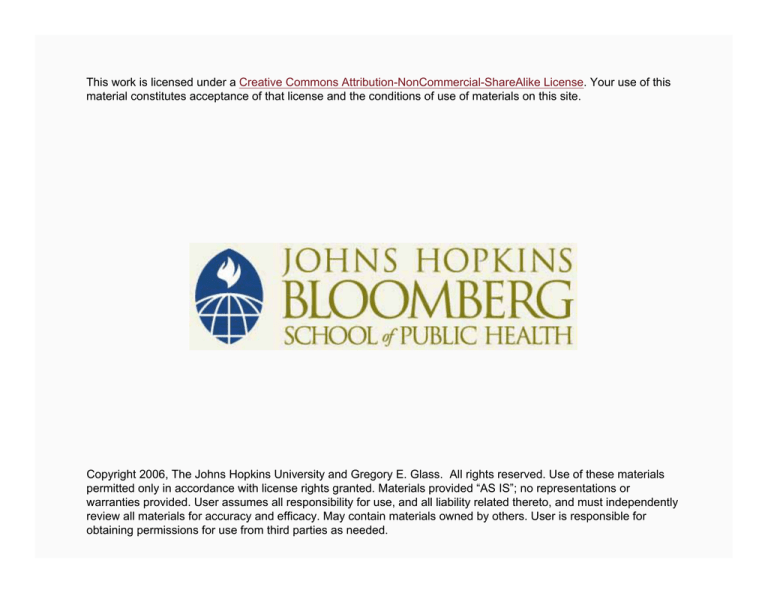
This work is licensed under a Creative Commons Attribution-NonCommercial-ShareAlike License. Your use of this
material constitutes acceptance of that license and the conditions of use of materials on this site.
Copyright 2006, The Johns Hopkins University and Gregory E. Glass. All rights reserved. Use of these materials
permitted only in accordance with license rights granted. Materials provided “AS IS”; no representations or
warranties provided. User assumes all responsibility for use, and all liability related thereto, and must independently
review all materials for accuracy and efficacy. May contain materials owned by others. User is responsible for
obtaining permissions for use from third parties as needed.
Ecological Principles of Disease Systems:
Population Interactions and Dynamics
Gregory E. Glass, PhD
Johns Hopkins University
Module 1 Introduction, by Dr. Vern Carruthers, PhD
Module 1: disease ecology
− Disease ecology principles
− Infectious diseases
− Dr. Greg Glass, professor of molecular
microbiology and immunology
3
Section A
Disease Ecology, Epidemiology, and Niche
Disease Ecology
In this lecture, we will:
− Characterize the biological level of organization
that disease ecology represents
− Differentiate disease ecology from observational
epidemiology
− Introduce the key concept of niche
− Demonstrate how niche overlap is related to risk of
disease
5
Ecology of Infectious Diseases
Differs from a traditional medical approach in that it’s
not concerned with describing the pathology of
individuals
Differs from epidemiology in that the emphasis is on
general processes of population interactions rather
than characterization of specific diseases
6
Differences with Epidemiology
Epidemiology: the study of the determinants of
diseases and injuries (in human populations)
− What causes disease?
− How do you identify the causes?
− Mechanistic
Disease ecology: the study of the underlying principles
that influence the spatio-temporal patterns of diseases
− Why do the patterns of disease occur as they do?
− Conceptual: what variables are important?
7
Epidemiologic Disease Model
Host
Agent
Environment
8
Disease Ecology Paradigm
Incidence, spatial distribution, and timing of diseases
reflect the interactions of populations with each other,
in the environment
9
Populations
Populations are systems of organisms interacting with
and in the environment, and these interactions result
in emergent properties
10
Emergent Properties
Emergent properties: outcomes of higher-order
interactions among components of a system that can’t
be anticipated by studying the components in
isolation
− Example: can the introduction of an efficacious
vaccine actually make a disease situation worse?
11
Ecology of Infectious Diseases
Basic concept of ecology is related to the niche
Niche: those sets of biotic and abiotic conditions in the
environment that define the limit of a species’ ability
to survive
In disease ecology, the dynamics of infectious disease
are viewed as the overlap in time-space of niches of
the component populations
12
Ecology and Public Health
100
Percent humidity (%)
90
Environment
80
70
Human
60
50
40
30
20
Pathogen
10
0
-50 -30 -10
10
30
50
70
90
110 130 150 170 190
Temperature (°F)
13
Examples of Population Interactions
Environmental diseases
− For example, toxins (lead poisoning), cancers,
environmental shortages, (famine)
ENVIRONMENT
Human
14
Infectious Diseases
Directly transmissible infectious disease
Two-population system
− For example, many viral (influenza, measles),
bacterial (tetanus), fungal (aspergillus) infections
ENVIRONMENT
Human
Pathogen
15
Zoonoses
Zoonotic diseases
− Pathogen primarily resides in a second species and
is transmitted to humans without
an intermediary species
X For example, rabies, schistosomiasis
ENVIRONMENT
Human
Pathogen
Reservoir
16
Vector-Borne/Zoonoses
Vector-borne diseases
− Infectious agents transmitted to humans through
action of another species
Many vector-borne diseases are transmitted by
arthropods
− For example,
ENVIRONMENT
Lyme disease,
bubonic plague,
Vector
Bartonelloses,
WNV
Human
Pathogen
Reservoir
17
Section B
Real-Life Examples
Examples of Rodent-Borne Pathogens
Organism
Host
Transmission
Capillaria hepatica R. norvegicus and other rodents
Oral
Trichinella spiralis R. norvegicus and other mammals
Oral
Yersinia pestis
R. norvegicus and other rodents
Vector
Leptospira
R. norvegicus and other mammals
Contact
LCMV
M. musculus
Aerosol
Hantaviruses
A. agrarius, R. norvegicus, C. glareolus Aerosol
19
Niche Differences—Example: LCMV
Family: Arenaviruses
Host: Mus musculus
(house mouse)
Transmission: air-borne
from feces, urine, saliva
Disease: aseptic
meningitis
Epidemiology: one of the
main causes of aseptic
meningitis in urban areas
20
Niche Differences—Example: Hantavirus
Family: Bunyaviruses
Host: P. maniculatus,
R. norvegicus, C. glareolus
Transmission: airborne
from feces, urine
Disease: hantaviral
pulmonary syndrome,
acute kidney failure
Photo: Greg Glass
21
Different Niches Affect Prevalence in Humans
Note: strikingly
different
prevalences for
LCMV and HTNV
The number of
people in sample
infected with
hantaviruses is
very small
A large fraction
had been infected
with LCMV
Graph used with permission of James E. Childs.
Source: Childs JE, Glass GE, Korch GW, Ksiazek TG, Leduc JW. Lymphocytic choriomeningitis virus
infection and house mouse (Mus musculus) distribution in urban Baltimore.
Am J Trop Med Hyg 1992 Jul;47(1):27–34.
22
Contacts Between Rats/Mice and Humans Differ
Baltimore, Maryland
Photo courtesy of
James E. Childs.
23
Rodent Exposure in Baltimore
Source: Adapted by CTLT from Childs JE, Glass GE, Korch GW, Ksiazek TG, Leduc JW.
Lymphocytic choriomeningitis virus infection and house mouse (Mus musculus) distribution
in urban Baltimore. Am J Trop Med Hyg 1992 Jul;47(1):27–34.
24
Niches and Consequences for Control
Example: Schistosomiasis
− Infection with Schistosoma spp.
− Eggs shed in feces or urine of infected individual
− Infect selected species of snails
− Eggs hatch into infective forms (cercariae) in water
− Prevalence in some villages Æ 80%
25
Schistosomiasis and Large-Scale Agro-Ecosystems
Schistosomiasis
is associated
with large-scale
agro-ecosystems
needing water
Agricultural field in Egypt affected by
building of Aswan Dam
Photo: Courtesy of Clive Shiff
26
Is Schistosomiasis an Occupational Disease?
Increased conditions are suitable for snails
Concurrent increase in human activity that contacts
with snails
Photo: Courtesy of Clive Shiff
27
Is Schistosomiasis Associated With ADL?
Water canal in Abioka village, Egypt
Study site for schistosomiasis and snail contact
Photo: Courtesy of Clive Shiff
28
Abioka Village
Over 900 out of 1500 sampling site had no snails
The majority of the canals at this site are unsuitable
environments for snail host
29
Hantaviral Pulmonary Syndrome (HPS)
Spatio-temporal fluctuations
in niche overlap affects
disease rates
HPS is associated with
hantaviruses from
sigmodontine rodents
Associated with capillary
leak syndrome,
noncardiogenic shock,
interstitial pulmonary
edema, respiratory failure
First recognized in spring,
1993
Courtesy of Jonathan Samet
30
Epidemic Curve
Mortality is extreme
Number of human
cases relatively low
− 327 cases as of
August, 2002
Number of cases
vary among years
Courtesy of Jonathan Samet
31
Hyper-Endemic Area for HPS in North America
Greg Glass
32
HPS: Southwestern, USA: 1992
Greg Glass
33
HPS: Southwestern, USA: 1993
Greg Glass
34
HPS: Southwestern, USA: 1995
Greg Glass
35
HPS: Southwestern, USA: 1998
Greg Glass
36
Grasslands/Herbaceous
Vegetation grows more rapidly, more lushly, longer
during season where risk is high
Grasslands/Herbaceous
10000
8000
NDVI factor 10k
6000
4000
2000
0
-2000
1
5
9 13 17 21 25 29 33 37 41 45 49 53
hi-risk
hi-risk
hi-risk
hi-risk
non-risk
non-risk
non-risk
non-risk
non-risk
DoY
Greg Glass
37
HPS and Elevation
HPS cases may be rare because people do not live at
elevations where persistent high-risk conditions are
common
16
14
12
10
8
6
4
2
0
15
00
16
00
17
00
18
00
19
00
20
00
21
00
22
00
23
00
24
00
25
00
26
00
27
00
28
00
29
00
30
00
Elevation (meters)
Controls (1450-2450m)
Refugia (1650-3400m)
Greg Glass
38
Summary
Populations: systems of organisms interacting with
and in the environment
Niches: sets of biotic and abiotic conditions in the
environment that define the limit of a species’ ability
to survive
Dynamics of infectious diseases: represent the overlap
in time-space of niches of the component populations
− The extent of overlap can vary with time and space
39







